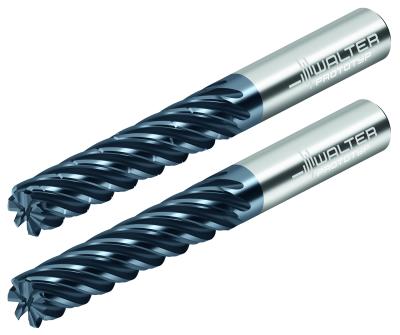
Walter has introduced the MD173 Supreme and the MD177 Supreme, its first solid carbide milling cutters with seven cutting edges. Developed to meet demanding applications in the aerospace industry, these high-performance mills excel in cutting not only titanium (ISO S), but also steels (ISO P), and stainless steels (ISO M) as well. With their seven teeth they achieve excellent productivity, while their variable pitch reduces vibration, ensuring smooth operation as well. Also, the entire length of the cutting edge can be used, providing relatively uniform wear, which extends the tool life of these milling cutters.
The MD173 Supreme is a roughing cutter designed specifically for dynamic milling and for reducing machining time. Its cutting edges equipped with chip breakers enable excellent chip breaking, permitting superior process reliability with high metal removal rates, a plus for users with automated production processes. The MD177 Supreme is a finishing cutter that creates very smooth surfaces without "waterlines." As a result of these characteristics, this milling cutter duo delivers both superior productivity and process reliability, with excellent surfaces. The MD177 Supreme is available in sizes 3/16 – 1 inch and in metric from 6-25mm, the MD173 Supreme in sizes 1/4 – 1 inch. Both versions are available with or without corner radii.
The Walter lineup of products consists of three categories to tools. Supreme indicates the highest level of technology and performance available. Perform tools are products that provide an economical solution with focused importance on price and Advance which indicates product efficiently balanced between price and performance.
Contact Details
Related Glossary Terms
- gang cutting ( milling)
gang cutting ( milling)
Machining with several cutters mounted on a single arbor, generally for simultaneous cutting.
- milling
milling
Machining operation in which metal or other material is removed by applying power to a rotating cutter. In vertical milling, the cutting tool is mounted vertically on the spindle. In horizontal milling, the cutting tool is mounted horizontally, either directly on the spindle or on an arbor. Horizontal milling is further broken down into conventional milling, where the cutter rotates opposite the direction of feed, or “up” into the workpiece; and climb milling, where the cutter rotates in the direction of feed, or “down” into the workpiece. Milling operations include plane or surface milling, endmilling, facemilling, angle milling, form milling and profiling.
- milling cutter
milling cutter
Loosely, any milling tool. Horizontal cutters take the form of plain milling cutters, plain spiral-tooth cutters, helical cutters, side-milling cutters, staggered-tooth side-milling cutters, facemilling cutters, angular cutters, double-angle cutters, convex and concave form-milling cutters, straddle-sprocket cutters, spur-gear cutters, corner-rounding cutters and slitting saws. Vertical cutters use shank-mounted cutting tools, including endmills, T-slot cutters, Woodruff keyseat cutters and dovetail cutters; these may also be used on horizontal mills. See milling.
- pitch
pitch
1. On a saw blade, the number of teeth per inch. 2. In threading, the number of threads per inch.
- roughing cutter
roughing cutter
Tool for high-volume metal removal; normally followed by finishing passes. See finishing tool.
- stainless steels
stainless steels
Stainless steels possess high strength, heat resistance, excellent workability and erosion resistance. Four general classes have been developed to cover a range of mechanical and physical properties for particular applications. The four classes are: the austenitic types of the chromium-nickel-manganese 200 series and the chromium-nickel 300 series; the martensitic types of the chromium, hardenable 400 series; the chromium, nonhardenable 400-series ferritic types; and the precipitation-hardening type of chromium-nickel alloys with additional elements that are hardenable by solution treating and aging.

